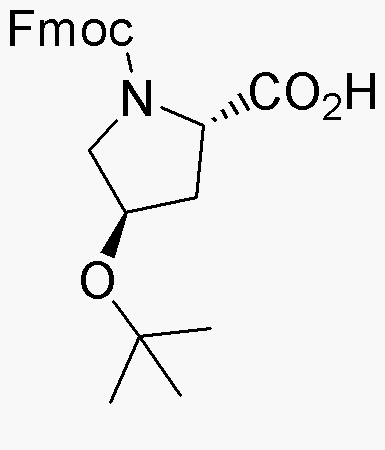Fmoc-O-tert-butyl-L-trans-4-hydroxyproline is widely utilized in research focused on:
- Peptide Synthesis: This compound is commonly used as a building block in the synthesis of peptides, particularly in solid-phase peptide synthesis, due to its stability and ease of removal during deprotection steps.
- Drug Development: It plays a crucial role in the development of pharmaceuticals, especially in creating compounds that target specific biological pathways, enhancing the efficacy of drug candidates.
- Bioconjugation: The chemical is valuable in bioconjugation processes, allowing researchers to attach biomolecules to surfaces or other molecules, which is essential for creating targeted therapies and diagnostics.
- Protein Engineering: In protein engineering, it helps in modifying proteins to improve their stability and functionality, making it easier to design proteins with desired characteristics for industrial applications.
- Research in Structural Biology: It is utilized in the study of protein structures, aiding in the understanding of protein folding and interactions, which is vital for advancing knowledge in biochemistry and molecular biology.
General Information
Properties
Safety and Regulations
Applications
Fmoc-O-tert-butyl-L-trans-4-hydroxyproline is widely utilized in research focused on:
- Peptide Synthesis: This compound is commonly used as a building block in the synthesis of peptides, particularly in solid-phase peptide synthesis, due to its stability and ease of removal during deprotection steps.
- Drug Development: It plays a crucial role in the development of pharmaceuticals, especially in creating compounds that target specific biological pathways, enhancing the efficacy of drug candidates.
- Bioconjugation: The chemical is valuable in bioconjugation processes, allowing researchers to attach biomolecules to surfaces or other molecules, which is essential for creating targeted therapies and diagnostics.
- Protein Engineering: In protein engineering, it helps in modifying proteins to improve their stability and functionality, making it easier to design proteins with desired characteristics for industrial applications.
- Research in Structural Biology: It is utilized in the study of protein structures, aiding in the understanding of protein folding and interactions, which is vital for advancing knowledge in biochemistry and molecular biology.
Documents
Safety Data Sheets (SDS)
The SDS provides comprehensive safety information on handling, storage, and disposal of the product.
Product Specification (PS)
The PS provides a comprehensive breakdown of the product’s properties, including chemical composition, physical state, purity, and storage requirements. It also details acceptable quality ranges and the product's intended applications.
Certificates of Analysis (COA)
Search for Certificates of Analysis (COA) by entering the products Lot Number. Lot and Batch Numbers can be found on a product’s label following the words ‘Lot’ or ‘Batch’.
*Catalog Number
*Lot Number
Certificates Of Origin (COO)
This COO confirms the country where the product was manufactured, and also details the materials and components used in it and whether it is derived from natural, synthetic, or other specific sources. This certificate may be required for customs, trade, and regulatory compliance.
*Catalog Number
*Lot Number
Safety Data Sheets (SDS)
The SDS provides comprehensive safety information on handling, storage, and disposal of the product.
DownloadProduct Specification (PS)
The PS provides a comprehensive breakdown of the product’s properties, including chemical composition, physical state, purity, and storage requirements. It also details acceptable quality ranges and the product's intended applications.
DownloadCertificates of Analysis (COA)
Search for Certificates of Analysis (COA) by entering the products Lot Number. Lot and Batch Numbers can be found on a product’s label following the words ‘Lot’ or ‘Batch’.
*Catalog Number
*Lot Number
Certificates Of Origin (COO)
This COO confirms the country where the product was manufactured, and also details the materials and components used in it and whether it is derived from natural, synthetic, or other specific sources. This certificate may be required for customs, trade, and regulatory compliance.


